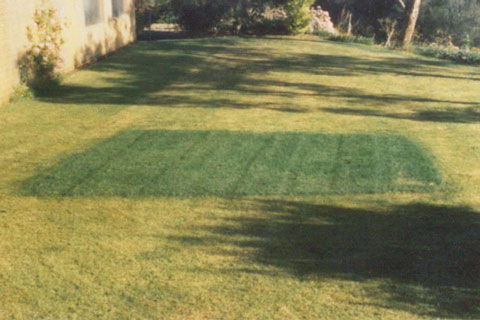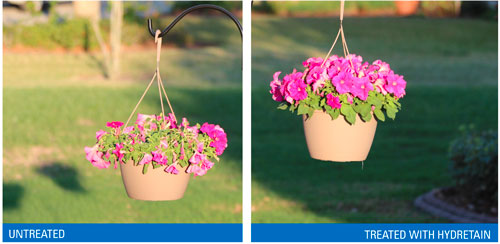4/1/2022
Improving Nutrient Uptake
Sarah Spatola

From plastic pots and tags to peat moss and fertilizers, it’s no secret that global supply chain issues are creating challenges across all facets of the green industry. Through a combination of increased demand and reduced availability, we’ve seen the cost of inputs soar to unprecedented levels.
Pictured: Ronn Hansen’s first application of hygroscopic humectants on a lawn.
As costs continue to climb, growers, retailers and consumers alike are encouraged to find alternative solutions and tools to increase efficiency. One such tool is the hygroscopic humectant water conservation technology known as Hydretain. Recent research from Western Illinois University shows that in addition to its water management properties, Hydretain is also effective in increasing nutrient uptake.
The Origin Story
In the late 1980s, an Australian chemist named Ronn Hansen began exploring the benefits of hygroscopic humectants for water conservation. Humectants are commonly used as conditioning agents in the food, cosmetic and personal care industries. They work by attracting water molecules from the surrounding atmosphere (or from the body) and binding those water molecules to their own molecules through hydrogen bonding. This property is known as hygroscopicity. The hygroscopic nature of each humectant varies widely based on its molecular structure. The more hygroscopic a humectant is, the more water it can bind at a specific humidity.
There are both organic and inorganic forms of humectants—organic by the chemistry definition referring to any compound that contains a carbon-hydrogen bond. Through research and product trials, Ronn learned that organic hygroscopic humectants provided an effective and environmentally friendly solution to roadway dust control. When applied to a dirt surface, they attract water molecules from above and below the surface to keep the surface nominally damp for longer periods between rainfall or roadway watering.
If it Works on Dust …
After proving the performance of hygroscopic humectants for roadway dust control, Ronn became curious about the chemistry’s ability to reduce drought stress and delay wilt for plant material. However, just as there are variations in the level of hygroscopicity of humectants, there are also variations in their ability to release that moisture back to the atmosphere or to surrounding substances.
Further research and development showed that the right combination of hygroscopic humectants could provide plant roots with additional moisture after soils or soilless media begins to dry out. As the soil or soilless media begins to dry, the hygroscopic humectants attract water molecules from the humidity that remains in the air between soil particles. The water molecules bond together, forming microscopic water droplets that plant roots can absorb.
Hydretain was brought to the United States by Ecologel Solutions in the early 1990s. The first U.S.-based research was conducted by Dr. Jim Barrett and Dr. Terril Nell at the University of Florida Institute of Food and Agricultural Sciences (UF/IFAS). At the time of the study, Jim and Terril were seeking solutions to help growers extend retail shelf life. The study was conducted on geraniums grown in 4-in. pots. The plants were observed for wilt and the days to wilt were recorded for both treated and untreated comparisons. The hygroscopic humectant technology proved to increase days to wilt by 80% to 120%. According to Jim, “The water-only plants wilted in five days, whereas the Hydretain-treated plants went nine to 11 days before wilting.”
If it Helps With Hydration …
Over the last 30 years, hygroscopic humectants have been widely researched and used across the horticultural and agricultural industries for their ability to reduce watering requirements, delay wilt, improve seed germination, increase crop yields, etc. However, it wasn’t until 2020 that research was conducted to explore the connection between their water-management properties and increased nutrient uptake.
Water is critical to the function and health of all plants. It’s the medium in which all essential biological processes occur. Without water, plants are unable to transport nutrients or convert those nutrients into the proteins, sugars and other organic components needed to survive.
“Over years of product use in golf, sports turf, nursery, landscape and residential markets, we have received field reports of plants exhibiting green up and growth that seemed to go beyond a water-management response alone,” said Ecologel’s Director of Agronomy Jim Spindler. “Because of the important role that water plays in nutrient availability and uptake, we’ve long suspected that hygroscopic humectants could be increasing nutrient uptake in two ways: the first is by maintaining channels of solubility for nutrients to move from soil sites to plant roots for uptake. The second is by keeping plants from going into drought stress, so they are able to continue extracting nutrients from the soil.”
 Pictured: Hydretain delays wilt for container plants as shown versus non-treated plants.
Pictured: Hydretain delays wilt for container plants as shown versus non-treated plants.
When plants lose more water than they can take up from the soil they become drought stressed. This form of stress is also sometimes referred to as water stress or moisture stress. When drought stress occurs, the biological processes associated with photosynthesis and plant growth begin to shut down as the plant enters a survival mode. As a result, nutrient demand is diminished. During periods of water stress, applied nutrients have a greater potential to volatilize or become tied up in the soil. Further, heavy watering to rewet dry soil can increase the risk of nutrient leaching.
The Nutrient Uptake Research
In April 2020, Dr. Shelby Henning, Assistant Professor of Sustainable Horticulture at Western Illinois University, began research to explore the relationship between the fertilizer uptake efficiency of cool-season turfgrass treated with and without Hydretain. He previously conducted research to observe the water conservation potential of hygroscopic humectants during which he noted that cool-season turfgrass treated with Hydretain demonstrated increased vegetative growth. It was presumed that this increase in vegetative growth would coincide with increased nutrient absorption.
For this study, turf-type perennial ryegrass (Lolium perenne L. Paragon) was seeded at a rate of 4 lbs. of pure live seed per 1,000 sq. ft. in 2-gal. plastic nursery containers filled with soilless media (Pro-Mix BioPlus). Once the vegetation reached its establishment height of 2.5 in., fertility applications were made to all pots using a complete fertilizer (20-20-20; Scott’s Company) at a rate of 1.0 lb. actual N/1,000 sq. ft. For the Hydretain treated containers, Hydretain was applied at the standard label rate of 9.0 fl. oz. per 1,000 sq. ft.
Immediately after treatments were applied, all pots were irrigated and irrigation was maintained at 24-hour intervals. Irrigation was slowly applied to limit surface runoff and each container was fitted with an impermeable polymer dish to limit possible nutrient losses.
Weekly clippings were harvested to maintain a turfgrass height of 2.5 in. Clippings were airdried for 24 hours after which dry mass was recorded. At the end of the study, the compiled clippings for each treatment were sent for total-N analysis at the University of Illinois, and then to Southeastern Agricultural Labs in Barney, Georgia, for P, K, S, Ca, Mg, B, Zn, Mn, Cu and Fe analysis.
Greater nutrient efficiency resulted in a 31% increase in dry matter when comparing Hydretain-treated clipping to controls. Further, differences in the nutrient value of the vegetative tissue were detected for nine (N, P, K, S, Ca, Mg, B, Mn, Cu) of the 11 elements sampled. When compared to the controls, the Hydretain treatment increased macronutrient uptake by 45%, 47% and 54% for N, P and K, respectively. Similarly, the Hydretain treatment increased uptake for secondary nutrients Ca, Mg and S by 41% 48% and 56%, respectively. Additionally, the Hydretain treatment increased tissue levels of B, Mn and Cu by 31%, 41% and 43%, respectively. Iron (Fe) and zinc (Zn) increases were not deemed statistically significant.
Though this study was conducted on cool-season turfgrass, the water management properties of hygroscopic humectants have proven effective on a wide variety of plant material. The reductions in watering demand and improvements in plant quality exhibited in turfgrass are similar to results achieved on trees, shrubs, flowering ornamentals, food crops and the like. It’s presumable that similar results of enhanced nutrient uptake would also be achieved across this variety of crops.
As nutrient prices continue to soar and availability becomes increasingly limited, it will be advantageous to provide customers with solutions that help maximize nutrient availability. Hygroscopic humectants offer a profitable opportunity to help customers maintain healthier plants while also helping them reduce their overall watering demands. GP
 Sarah Spatola is the Director of Marketing for Ecologel Solutions, LLC. In addition to her role at Ecologel, she is also serving as the current President of the Florida Nursery, Growers and Landscape Association.
Sarah Spatola is the Director of Marketing for Ecologel Solutions, LLC. In addition to her role at Ecologel, she is also serving as the current President of the Florida Nursery, Growers and Landscape Association.